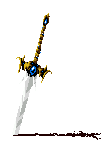 Yes, the Genesis is often dismissed when the subject of RPGs comes up. Many people seem to think that the system is devoid of any games worth mentioning. Anyone with half a brain could see that this is simply not the case. Though not on the same level as the SNES’ Square-filled majesty, the Genny is not one to be sneered at either. There may not be as many, but the overall quality far outweighs the quantity, and some of the most classic franchises in the genre to this day either made an appearance or got their start on the console. Where would Shining Force NEO be without Shining in the Darkness? Playstation owners can thank the Sega CD for making the Lunar series so successful, and owners of everything from the Dreamcast to the Xbox and PC are now playing in the Phantasy Star world. Remember that the next time someone snickers about the lack of RPGs on the Genesis.
Yes, the Genesis is often dismissed when the subject of RPGs comes up. Many people seem to think that the system is devoid of any games worth mentioning. Anyone with half a brain could see that this is simply not the case. Though not on the same level as the SNES’ Square-filled majesty, the Genny is not one to be sneered at either. There may not be as many, but the overall quality far outweighs the quantity, and some of the most classic franchises in the genre to this day either made an appearance or got their start on the console. Where would Shining Force NEO be without Shining in the Darkness? Playstation owners can thank the Sega CD for making the Lunar series so successful, and owners of everything from the Dreamcast to the Xbox and PC are now playing in the Phantasy Star world. Remember that the next time someone snickers about the lack of RPGs on the Genesis.
On a related note, the games listed below are only domestic releases of RPG and action/RPG games. Strategy games like Dark Wizard will appear in a separate feature. For a complete listing or import RPGS, check out our feature Left in Japan: RPGs for another twenty-six games!
Arcus Odyssey
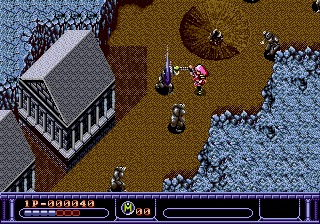 The few who have played the Mega CD collection of Arcus I, II, & III are probably a bit disappointed with Arcus Odyssey on the Genesis. Instead of a dungeon crawler, the whole game has been changed to an isometric action/RPG. Some characters are found in both versions, but the plots have changed. What we got doesn’t resemble the original, but is still a great game. The four selectable characters give it some replay value, and choosing NPCs to aid you in your quest was a pretty unique feature on consoles at the time. The graphics and sound aren’t the best, but there are some cool effects in the levels (love the water warping!) and the cut scenes are of typical Renovation caliber. The difficulty level may hurt first impressions, but in time it will change your opinion. Once you’ve grasped how to use magic and items, things become a lot easier. An important thing to also remember is that it’s not all about killing everything that moves. It’s more important to complete the objectives and get the heck out of dodge than it is to eliminate all the baddies (who respawn anyway). Going in with a Gauntlet mentality only guarantees frustration. Though challenging and not the best game graphically, Arcus Odyssey still manages to entertain and provides some great action/RPG fun for a cheap price.
The few who have played the Mega CD collection of Arcus I, II, & III are probably a bit disappointed with Arcus Odyssey on the Genesis. Instead of a dungeon crawler, the whole game has been changed to an isometric action/RPG. Some characters are found in both versions, but the plots have changed. What we got doesn’t resemble the original, but is still a great game. The four selectable characters give it some replay value, and choosing NPCs to aid you in your quest was a pretty unique feature on consoles at the time. The graphics and sound aren’t the best, but there are some cool effects in the levels (love the water warping!) and the cut scenes are of typical Renovation caliber. The difficulty level may hurt first impressions, but in time it will change your opinion. Once you’ve grasped how to use magic and items, things become a lot easier. An important thing to also remember is that it’s not all about killing everything that moves. It’s more important to complete the objectives and get the heck out of dodge than it is to eliminate all the baddies (who respawn anyway). Going in with a Gauntlet mentality only guarantees frustration. Though challenging and not the best game graphically, Arcus Odyssey still manages to entertain and provides some great action/RPG fun for a cheap price.
Battlemaster
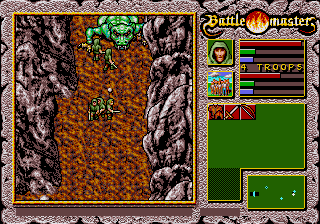 I have heard people praise this game, and I’ve seen lots of good things written about it. Yet after playing it, I honestly don’t see what all the accolades are about. The graphics are decent at best, the sound it nothing exciting, and the gameplay is as bare bones and uninspiring as can be. Being able to choose from four different character, each with their own group of four warriors, seems like a neat idea until it’s actually implemented. You basically end up walking around slinging arrows at anything that moves, and your troops get stuck behind trees, walls, and just about everything else. This leads to you having to constantly pause the game and reorganize them. Unfortunately, the stupid twits take every opportunity to go and get lost, stay outside when you enter a door, etc. It’s not fun at all. With all these things going against it, I really don’t see the need to play Battlemaster, especially when other games like Shining Force take the troop dynamic and actually do it the right way.
I have heard people praise this game, and I’ve seen lots of good things written about it. Yet after playing it, I honestly don’t see what all the accolades are about. The graphics are decent at best, the sound it nothing exciting, and the gameplay is as bare bones and uninspiring as can be. Being able to choose from four different character, each with their own group of four warriors, seems like a neat idea until it’s actually implemented. You basically end up walking around slinging arrows at anything that moves, and your troops get stuck behind trees, walls, and just about everything else. This leads to you having to constantly pause the game and reorganize them. Unfortunately, the stupid twits take every opportunity to go and get lost, stay outside when you enter a door, etc. It’s not fun at all. With all these things going against it, I really don’t see the need to play Battlemaster, especially when other games like Shining Force take the troop dynamic and actually do it the right way.
Beggar Prince
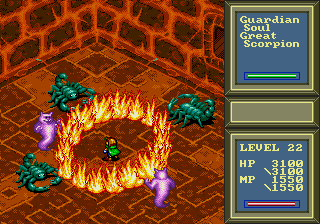 What else can be said about Super Fighter Team’s stellar Genesis debut? After almost a decade of silence, the Genesis roars back to life once more with Beggar Prince. A retelling of the classic tale the Prince and the Pauper, this “new” RPG hails from Taiwan, and what is most interesting about its release is that it has been given the full blessing of the original publisher, C&E Inc. The single-character adventure features some great visuals and a witty plot, and it comes packaged in a full plastic clamshell case with color insert and manual. Copies can still be had at the official site, so hurry over and pick one up. You don’t want to end up on the wrong side of history with this one!
What else can be said about Super Fighter Team’s stellar Genesis debut? After almost a decade of silence, the Genesis roars back to life once more with Beggar Prince. A retelling of the classic tale the Prince and the Pauper, this “new” RPG hails from Taiwan, and what is most interesting about its release is that it has been given the full blessing of the original publisher, C&E Inc. The single-character adventure features some great visuals and a witty plot, and it comes packaged in a full plastic clamshell case with color insert and manual. Copies can still be had at the official site, so hurry over and pick one up. You don’t want to end up on the wrong side of history with this one!
Beyond Oasis
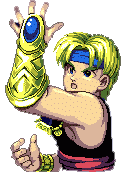 I love this game, so much that it’s one of the few Genesis titles that has only been through my hands once. I bought my copy at release and have never gotten rid of it. A great blend of action, platforming, and RPG, Beyond Oasis was a great original debut for Yuzo Koshiro’s Ancient company, and does a great job of showing just what the Genesis has to offer fans of the genre. In my humble opinion, it is superior to its Saturn prequel, Legend of Oasis, in that it its objectives are much easier to understand, and the dungeons aren’t so tedious. Beyond Oasis is also much shorter, clocking in at just over six hours game time (I cut that to three hours the second time through). That’s not as long as other action/RPG staples, like Crusader of Centy and the Zelda series, but that’s not really a bad thing, since the action is pretty fast paced. It is seriously a lot of fun and is a game that should be in every Genesis owner’s collection.
I love this game, so much that it’s one of the few Genesis titles that has only been through my hands once. I bought my copy at release and have never gotten rid of it. A great blend of action, platforming, and RPG, Beyond Oasis was a great original debut for Yuzo Koshiro’s Ancient company, and does a great job of showing just what the Genesis has to offer fans of the genre. In my humble opinion, it is superior to its Saturn prequel, Legend of Oasis, in that it its objectives are much easier to understand, and the dungeons aren’t so tedious. Beyond Oasis is also much shorter, clocking in at just over six hours game time (I cut that to three hours the second time through). That’s not as long as other action/RPG staples, like Crusader of Centy and the Zelda series, but that’s not really a bad thing, since the action is pretty fast paced. It is seriously a lot of fun and is a game that should be in every Genesis owner’s collection.
Buck Rogers: Countdown to Doomsday
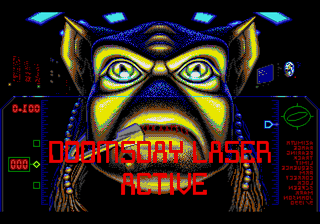 Buck Rogers: Countdown to Doomsday is perhaps the only game in the world that I honestly, truly hate. I’m not talking about a strong dislike, either. I mean a seething, burning hatred, the kind that keeps your soul from moving on to the next world after you die. It wasn’t the mediocre early PC-like graphics, the tinny sound, or stupid character animation (that walk!). No, it wasn’t any of that. I can learn to live with sloppy presentation, so long as the gameplay is solid. That, my friend, is where Buck Rogers fails miserably. How on Earth anyone could create an RPG where any character that dies in battle remains dead for the rest of the game is simply beyond my comprehension. I had a character die within the first hour of play and had to drag his corpse throughout the adventure up until the last boss battle, which was of course, impossible, given that I was one character short. It’s a pity, as the game does have a few redeeming qualities, just not enough to take it off my shit list- which it has been on since 1993.
Buck Rogers: Countdown to Doomsday is perhaps the only game in the world that I honestly, truly hate. I’m not talking about a strong dislike, either. I mean a seething, burning hatred, the kind that keeps your soul from moving on to the next world after you die. It wasn’t the mediocre early PC-like graphics, the tinny sound, or stupid character animation (that walk!). No, it wasn’t any of that. I can learn to live with sloppy presentation, so long as the gameplay is solid. That, my friend, is where Buck Rogers fails miserably. How on Earth anyone could create an RPG where any character that dies in battle remains dead for the rest of the game is simply beyond my comprehension. I had a character die within the first hour of play and had to drag his corpse throughout the adventure up until the last boss battle, which was of course, impossible, given that I was one character short. It’s a pity, as the game does have a few redeeming qualities, just not enough to take it off my shit list- which it has been on since 1993.
Cadash
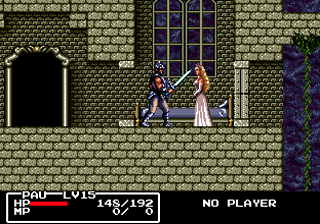 Cadash is the perfect example of why it sometimes isn’t a good idea to mix genres. The arcade aspect of it is excellent and engaging, but the RPG elements bog the action down, and bring the game practically to a halt. They seem to be simply tacked on, and never get deep enough to even warrant being there. All items you buy are used automatically, so what’s the point? The game has a decidedly Adventure of Link/Lord of the Sword feel to it, but is decidedly inferior to its Turbo Grafx-16 cousin in that it sports less color and two fewer characters from which to choose (the ninja and paladin are gone). I don’t think the gameplay is really any better than that version, as your character is very stiff and slow. I know this is an early Genesis title, but there’s not enough meat here to satisfy any discerning RPG gamer’s appetite. If you’re really in the mood for some Taito sword-swinging action, try Saint Sword, as it’s more arcadey and straight forward.
Cadash is the perfect example of why it sometimes isn’t a good idea to mix genres. The arcade aspect of it is excellent and engaging, but the RPG elements bog the action down, and bring the game practically to a halt. They seem to be simply tacked on, and never get deep enough to even warrant being there. All items you buy are used automatically, so what’s the point? The game has a decidedly Adventure of Link/Lord of the Sword feel to it, but is decidedly inferior to its Turbo Grafx-16 cousin in that it sports less color and two fewer characters from which to choose (the ninja and paladin are gone). I don’t think the gameplay is really any better than that version, as your character is very stiff and slow. I know this is an early Genesis title, but there’s not enough meat here to satisfy any discerning RPG gamer’s appetite. If you’re really in the mood for some Taito sword-swinging action, try Saint Sword, as it’s more arcadey and straight forward.
Crusader of Centy
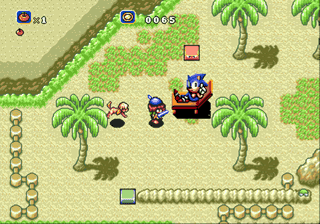 Most people’s initial impression of Crusader of Centy is that it is a Zelda clone. That may well be true, as the influence of Nintendo’s monster action/RPG is blatantly apparent from the get-go. Is this a bad thing? Not at all. They say that imitation is the sincerest form of flattery, and when it’s done as good as this Atlus’ release, you’re quick to forgive the lack of… inspiration. To be fair, it doesn’t copy everything from Zelda, though, and includes the strange dynamic of letting you use animals instead of bows and other weapons, and soon into the game you gain the ability to talk to them. They either attach to you or your sword, increasing your move list. The lion, for example, adds flame to your sword when thrown. Even cooler is that you can mix and match the animals for different weapons effects. Combine that lion with, say, a penguin, and you get a flying ice sword, which is extremely powerful.
Most people’s initial impression of Crusader of Centy is that it is a Zelda clone. That may well be true, as the influence of Nintendo’s monster action/RPG is blatantly apparent from the get-go. Is this a bad thing? Not at all. They say that imitation is the sincerest form of flattery, and when it’s done as good as this Atlus’ release, you’re quick to forgive the lack of… inspiration. To be fair, it doesn’t copy everything from Zelda, though, and includes the strange dynamic of letting you use animals instead of bows and other weapons, and soon into the game you gain the ability to talk to them. They either attach to you or your sword, increasing your move list. The lion, for example, adds flame to your sword when thrown. Even cooler is that you can mix and match the animals for different weapons effects. Combine that lion with, say, a penguin, and you get a flying ice sword, which is extremely powerful.
The plot is your standard “boy coming of age just in time to save the world” fare, but that’s ok. The great graphics and compelling gameplay more than make up for the paper-thin storyline. Besides, didn’t just about all RPGs from this era have a story more or less like this one? It could have been worse, and you could have started the adventure asleep, and your mom giving you the tired “wake up, sleepyhead” line.
Dungeons & Dragons: Eye of the Beholder
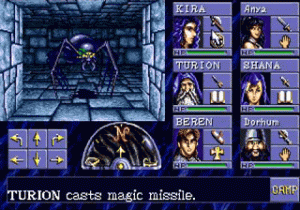
Here’s another great RPG, this time on the Sega CD. It’s fitting that Eye of the Beholder should be here, as it does everything Warriors did right, and kicks it up a notch. The graphics are much clearer and brighter, there’s voices galore, the auto map is permanent, and the game is scored by none other than Yuzo Koshiro himself. If you’re beginning to grimace, thinking that this is the same game as the SNES EotB, you’re very, very wrong. SSI took full advantage of the new format and added in multiple forms of play, which is sure to please just about everyone. You can use the standard on-screen arrows to move around, the Mega Mouse for a more PC-like feel, or you can go to the options menu and choose mode two, which lets you maneuver with the D pad. This last option is the easiest and most fluid, but you do have other choices if that’s not your thing.
Don’t listen to the naysayers; this is one of the most underrated RPGs out there, and one of the best on the Sega CD. If you have the system, you owe it to yourself to try this one out.
Dungeons & Dragons: Warriors of the Eternal Sun
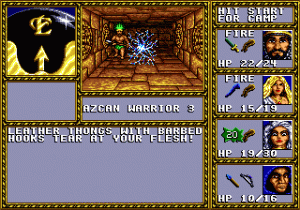 Here’s a game that took me by surprise. After years of avoiding it, I finally said “what the hell” and got a copy of Warriors of the Eternal Sun. What the game lacked graphically, it compensated for in gameplay and immersion. As a group of adventurers who have been whisked away (along with an entire castle community) to an unknown valley, you must uncover the secret of where you are and how to return. The only problem is that town is slowly going mad as time passes. Hurry or it’ll be too late!
Here’s a game that took me by surprise. After years of avoiding it, I finally said “what the hell” and got a copy of Warriors of the Eternal Sun. What the game lacked graphically, it compensated for in gameplay and immersion. As a group of adventurers who have been whisked away (along with an entire castle community) to an unknown valley, you must uncover the secret of where you are and how to return. The only problem is that town is slowly going mad as time passes. Hurry or it’ll be too late!
Using a steep overhead view for the field, the game changes to a first-person perspective inside dungeons. Combat is reminiscent of the D&D PC games of old, and you can quickly get lost in the massive dungeons that permeate the landscape. This can be a big problem, as your auto map resets every time you re-enter a cave or labyrinth. I guess that’s what graph paper is for! Probably the biggest problem here is the tremendous difficulty level Warriors heaps upon you right from the start. Combat takes some getting used to, and a lot of leveling up is required. Hey, I did say it was old school, remember?
Dungeon Explorer
 Gauntlet fans should be very pleased with Dungeon Explorer. It takes everything about that arcade hit and adds some great RPG elements to it. The quest mode in Gauntlet IV was similar to it, but not as expansive. Dungeon Explorer offers a series of labyrinths to explore with up to four players, each with their own enemies and bosses. Beef up your character’s stats and equipment, and even interchange heroes in the course of an adventure! A stunning soundtrack compliments the action/RPG goodness, and really does a great job of motivating you. This is one of those games which are always better in groups, but going it solo is still a lot of fun. Those familiar with the Turbo Grafx-16 version of Dungeon Explorer may be wondering what the differences between the two are, and lucky for you, we’ve got you covered with our Side by Side comparison.
Gauntlet fans should be very pleased with Dungeon Explorer. It takes everything about that arcade hit and adds some great RPG elements to it. The quest mode in Gauntlet IV was similar to it, but not as expansive. Dungeon Explorer offers a series of labyrinths to explore with up to four players, each with their own enemies and bosses. Beef up your character’s stats and equipment, and even interchange heroes in the course of an adventure! A stunning soundtrack compliments the action/RPG goodness, and really does a great job of motivating you. This is one of those games which are always better in groups, but going it solo is still a lot of fun. Those familiar with the Turbo Grafx-16 version of Dungeon Explorer may be wondering what the differences between the two are, and lucky for you, we’ve got you covered with our Side by Side comparison.
Dungeon Master II: Skullkeep
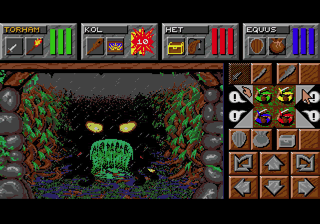 I made the mistake of playing Dungeon Master II: Skullkeep immediately after having finished Eye of the Beholder, and it took quite a bit of getting used to. It was frustrating to not have the D-pad option that Eye offered, and using those tiny arrows to move around was sheer torture. I’m sure this would have been a non-issue had I a Mega Mouse, but as it was, the game was very difficult to play. Overall, Dungeon Master II: Skullkeep is the same as the PC original, but the lack of modifications to the gameplay when it made the transition really hurt it, unless you have the mouse. The graphics and sound are quite good, and the quest is long and challenging. If you’re in the market for a Sega CD adventure of this type and aren’t equipped to play DM II, I recommend you try Eye of the Beholder, which took the changes in format into account when it arrived on the Sega CD. If you have the means though, then give this one a try.
I made the mistake of playing Dungeon Master II: Skullkeep immediately after having finished Eye of the Beholder, and it took quite a bit of getting used to. It was frustrating to not have the D-pad option that Eye offered, and using those tiny arrows to move around was sheer torture. I’m sure this would have been a non-issue had I a Mega Mouse, but as it was, the game was very difficult to play. Overall, Dungeon Master II: Skullkeep is the same as the PC original, but the lack of modifications to the gameplay when it made the transition really hurt it, unless you have the mouse. The graphics and sound are quite good, and the quest is long and challenging. If you’re in the market for a Sega CD adventure of this type and aren’t equipped to play DM II, I recommend you try Eye of the Beholder, which took the changes in format into account when it arrived on the Sega CD. If you have the means though, then give this one a try.
Exile
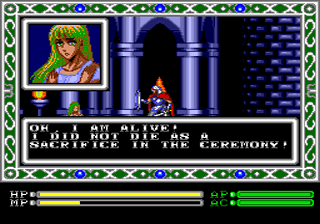 Renovation gave Genesis fans a few Turbo CD gems, like Valis III, Ys III, and Exile. Though lacking the amazing soundtracks and detailed cut scenes of those versions, things turned out pretty well on cartridge, and out of all of them, Exile is perhaps the one that suffered the least in the transition. It tells the tale of Sadler, a desert hero who must resolve a war between kingdoms. Along the way, he gathers companions and tackles many a standard dungeon. The difference is that while the towns are explored via your standard overhead RPG view (like Phantasy Star), the dungeons are all side-scrolling adventures, in which Sadler’s company of friends are glaringly absent. Seriously, each of them always has a convenient excuse for not going into a dungeon with you, and you end up having to fly solo for most of the game. Sadler’s a pretty strong guy, so this isn’t really a problem, and the decent cut scenes sprinkled throughout the game help to make up for this weird dynamic. I personally prefer the TG-CD version of Exile, due to its much more thorough presentation, but everything else is essentially the same, including the ho-hum graphics. It’s quite a decent adventure and should provide some fun for those looking for their next RPG fix.
Renovation gave Genesis fans a few Turbo CD gems, like Valis III, Ys III, and Exile. Though lacking the amazing soundtracks and detailed cut scenes of those versions, things turned out pretty well on cartridge, and out of all of them, Exile is perhaps the one that suffered the least in the transition. It tells the tale of Sadler, a desert hero who must resolve a war between kingdoms. Along the way, he gathers companions and tackles many a standard dungeon. The difference is that while the towns are explored via your standard overhead RPG view (like Phantasy Star), the dungeons are all side-scrolling adventures, in which Sadler’s company of friends are glaringly absent. Seriously, each of them always has a convenient excuse for not going into a dungeon with you, and you end up having to fly solo for most of the game. Sadler’s a pretty strong guy, so this isn’t really a problem, and the decent cut scenes sprinkled throughout the game help to make up for this weird dynamic. I personally prefer the TG-CD version of Exile, due to its much more thorough presentation, but everything else is essentially the same, including the ho-hum graphics. It’s quite a decent adventure and should provide some fun for those looking for their next RPG fix.
Faery Tale Adventure
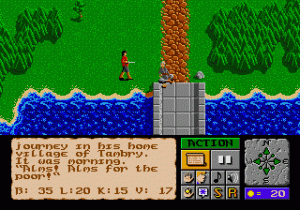 The first of several titles on this list by Amiga and PC RPG gurus New World Computing, Faery Tale Adventure sits right at the top, in my opinion, above both Might & Magic and King’s Bounty. It was hailed at the time as having the largest in-game world of any RPG (almost 17,000 screens), and actually plays quite well on the Genesis, much better in fact, then the two aforementioned titles. As one of three brothers, you set out to recover a powerful talisman to save your village from impending evil. The game plays from an isometric view, and features lots of subquests that you can tackle at your leisure (there’s no time limit). You may at first think that Faery Tale Adventure must maintain the high learning curve New World’s other Genesis offerings boast, you’d be wrong to do so. It’s actually quite easy to get into and isn’t really all that hard at all, once you know how to use the interface. Overall, it’s a great jump-on point for RPG newbies and some relaxing fun for veterans. There’s lots of variety in the levels and characters you meet, and the adventure itself is a classic one.
The first of several titles on this list by Amiga and PC RPG gurus New World Computing, Faery Tale Adventure sits right at the top, in my opinion, above both Might & Magic and King’s Bounty. It was hailed at the time as having the largest in-game world of any RPG (almost 17,000 screens), and actually plays quite well on the Genesis, much better in fact, then the two aforementioned titles. As one of three brothers, you set out to recover a powerful talisman to save your village from impending evil. The game plays from an isometric view, and features lots of subquests that you can tackle at your leisure (there’s no time limit). You may at first think that Faery Tale Adventure must maintain the high learning curve New World’s other Genesis offerings boast, you’d be wrong to do so. It’s actually quite easy to get into and isn’t really all that hard at all, once you know how to use the interface. Overall, it’s a great jump-on point for RPG newbies and some relaxing fun for veterans. There’s lots of variety in the levels and characters you meet, and the adventure itself is a classic one.
Fatal Labyrinth
Oh,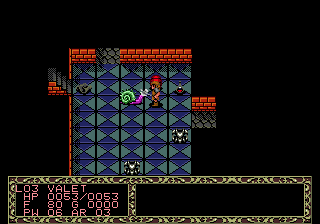 how I wanted to like Fatal Labyrinth. I was the only one of my circle of friends willing to give it a chance, renting it first, then buying it. I played it all the way through to the last boss, taking the regressions heaped upon me each time I continued, but when that boss fried me and sent me back a shitload of levels and forced me to climb all the way back to the top, I threw in the towel. There was so much potential here: sprite changes depending on what weapon/armor you had equipped, a food system that forced you to maintain your energy a la Gauntlet, a weight system that made you pick only the best stuff to carry; *sigh* the list goes on and on. The saddest part is that the whole package was done in by the bone-headed decision to not include a password or save feature. Thirty random levels in one sitting is not nearly as appetizing as it may seem, especially when you have to redo about five of them each time you get killed. I really tried my best to like Fatal Labyrinth, and a simple password feature would have made all the difference in the world. As it is, the game’s name must be referring to your will to play, and I can’t see anyone giving this more than a passing glance.
how I wanted to like Fatal Labyrinth. I was the only one of my circle of friends willing to give it a chance, renting it first, then buying it. I played it all the way through to the last boss, taking the regressions heaped upon me each time I continued, but when that boss fried me and sent me back a shitload of levels and forced me to climb all the way back to the top, I threw in the towel. There was so much potential here: sprite changes depending on what weapon/armor you had equipped, a food system that forced you to maintain your energy a la Gauntlet, a weight system that made you pick only the best stuff to carry; *sigh* the list goes on and on. The saddest part is that the whole package was done in by the bone-headed decision to not include a password or save feature. Thirty random levels in one sitting is not nearly as appetizing as it may seem, especially when you have to redo about five of them each time you get killed. I really tried my best to like Fatal Labyrinth, and a simple password feature would have made all the difference in the world. As it is, the game’s name must be referring to your will to play, and I can’t see anyone giving this more than a passing glance.
Gauntlet IV
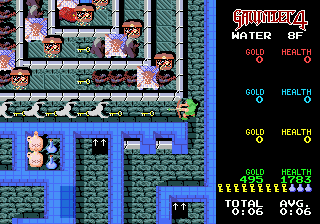 Before you start wondering why I’ve chosen to include what is seemingly the billionth port of this classic arcade game, let me remind you of this version’s awesome Quest Mode. Taking the already familiar gameplay of the original adventure, Tengen added some interesting RPG elements to Gauntlet 4 that make it deeper and more fun than ever. You can now upgrade your stats (permanently), weapons, and purchase items to use in battle. Featuring four element-themed towers that are both expansive and challenging, the Quest Mode will add hours of life to one of the definitive multi-player titles on the Genesis. Oh yes, did I mention that you can bring up to three friends along on this adventure, which you can save via password and return to later on? Well yes you can! You’ll need them too, as each tower has a dragon boss that needs to be dispatched to open the seal that bars entry to the real dungeon – the castle. I can’t recommend this one enough folks, and Tengen’s tweaking has made a legendary coin-op game even greater.
Before you start wondering why I’ve chosen to include what is seemingly the billionth port of this classic arcade game, let me remind you of this version’s awesome Quest Mode. Taking the already familiar gameplay of the original adventure, Tengen added some interesting RPG elements to Gauntlet 4 that make it deeper and more fun than ever. You can now upgrade your stats (permanently), weapons, and purchase items to use in battle. Featuring four element-themed towers that are both expansive and challenging, the Quest Mode will add hours of life to one of the definitive multi-player titles on the Genesis. Oh yes, did I mention that you can bring up to three friends along on this adventure, which you can save via password and return to later on? Well yes you can! You’ll need them too, as each tower has a dragon boss that needs to be dispatched to open the seal that bars entry to the real dungeon – the castle. I can’t recommend this one enough folks, and Tengen’s tweaking has made a legendary coin-op game even greater.
Heimdall
I’ve always been something of a fan of Norse mythology, and that was what initially attracted me to Heimdall. As the god charged with guarding the Rainbow Bridge- the entrance to the Asgard, home of the gods- you must recover the sacred weapons of Odin, Frey, and Thor before the coming of Ragnarok (the end of the world to all you non-fans). Loki, the god of mischief, has hidden them in three different worlds: Midgard (Earth), Utgard (home of the giants), and Asgard itself. Each of the worlds has around fifteen islands, all containing an insane number of rooms, so sit back and relax; you’re going to be here a while.
 The isometric view worked well on the Amiga and still does on the Sega CD. In fact, the CD version looks almost identical to its computer counterpart; for once the Genny’s limited color palate wasn’t a detriment. The real-time combat is fun and challenging, and how strong you are depends on how well you did in the three mini games at the beginning of the adventure. Axe throwing (not easy since you’re drunk), pig catching, and long boat fighting all seem harmless enough at first, but have serious implications. The better you do at each game, the strong your stats will be and the more warriors will join you. You can have up to thirty, and some of the harder ones to get are worth the effort it takes to master the mini games. The actual puzzle-solving gameplay and item collecting reminds me a lot of The Immortal, which is a good thing. Many people tend to overlook Heimdall on the Sega CD, and that needs to be rectified. This is a solid action/RPG that blends action, good storytelling, and humor for a great adventure that deserves to be played.
The isometric view worked well on the Amiga and still does on the Sega CD. In fact, the CD version looks almost identical to its computer counterpart; for once the Genny’s limited color palate wasn’t a detriment. The real-time combat is fun and challenging, and how strong you are depends on how well you did in the three mini games at the beginning of the adventure. Axe throwing (not easy since you’re drunk), pig catching, and long boat fighting all seem harmless enough at first, but have serious implications. The better you do at each game, the strong your stats will be and the more warriors will join you. You can have up to thirty, and some of the harder ones to get are worth the effort it takes to master the mini games. The actual puzzle-solving gameplay and item collecting reminds me a lot of The Immortal, which is a good thing. Many people tend to overlook Heimdall on the Sega CD, and that needs to be rectified. This is a solid action/RPG that blends action, good storytelling, and humor for a great adventure that deserves to be played.
Immortal
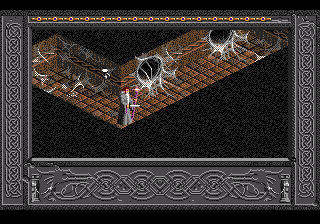 The blood! The horrible, horrible death sequences! The maddening difficulty! Those are probably the first things people associate with The Immortal, and probably not in that order. This was a great game, and one of the most difficult action/RPGs I’ve ever come across. With some trial and error, things get easier, but damn if each room doesn’t have its way with you the first time you enter. Ported from the PC in all its bloody glory (gory?) to first the NES and then Genesis, it marveled gamers with the extremely painful ways it was possible to die. Whether it was exploding your opponent’s head, or you yourself being swallowed whole by a giant worm, dying was almost as much fun as the game itself. Being the PC game that it was, The Immortal had its fair share of mind-wracking puzzles that could take hours to complete, but that was half the fun, wasn’t it?
The blood! The horrible, horrible death sequences! The maddening difficulty! Those are probably the first things people associate with The Immortal, and probably not in that order. This was a great game, and one of the most difficult action/RPGs I’ve ever come across. With some trial and error, things get easier, but damn if each room doesn’t have its way with you the first time you enter. Ported from the PC in all its bloody glory (gory?) to first the NES and then Genesis, it marveled gamers with the extremely painful ways it was possible to die. Whether it was exploding your opponent’s head, or you yourself being swallowed whole by a giant worm, dying was almost as much fun as the game itself. Being the PC game that it was, The Immortal had its fair share of mind-wracking puzzles that could take hours to complete, but that was half the fun, wasn’t it?
King’s Bounty
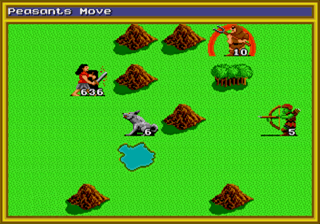 A fifty-six character password. When that is what you remember most about an RPG, something is most definitely wrong. For years I had blocked out the laughable graphics and almost nonexistent sound King’s Bounty slings at you with all the might of a retarded Ewok, but this one, incredible piece of trivia has been permanently etched into the annals of my brain. I can still see the daunting password screen in my mind’s eye, and it is a terrible, terrible sight. Don’t hate it for the absolutely horrid gameplay and simply atrocious sound, hate it for just how much it hates you. King’s Bounty insults your intelligence (a hidden treasure cache right in plain sight?), burns your retinas with graphics that don’t even make a half-ass attempt at using the Genesis’ power, makes your ears bleed with the most annoying field theme ever written, and then knocks you out cold with its stale battle scenes. Seriously, anyone who thrives on pain and suffering need look no further than the massive shit stain New World Computing and EA smeared across the Genesis back in 1991.
A fifty-six character password. When that is what you remember most about an RPG, something is most definitely wrong. For years I had blocked out the laughable graphics and almost nonexistent sound King’s Bounty slings at you with all the might of a retarded Ewok, but this one, incredible piece of trivia has been permanently etched into the annals of my brain. I can still see the daunting password screen in my mind’s eye, and it is a terrible, terrible sight. Don’t hate it for the absolutely horrid gameplay and simply atrocious sound, hate it for just how much it hates you. King’s Bounty insults your intelligence (a hidden treasure cache right in plain sight?), burns your retinas with graphics that don’t even make a half-ass attempt at using the Genesis’ power, makes your ears bleed with the most annoying field theme ever written, and then knocks you out cold with its stale battle scenes. Seriously, anyone who thrives on pain and suffering need look no further than the massive shit stain New World Computing and EA smeared across the Genesis back in 1991.
Landstalker: Treasure of King Nole
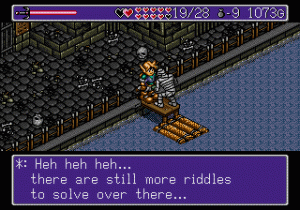 Landstalker is a unique phenomenon in gaming. It’s a game that can make players both praise and curse it in the same sentence. They love the graphics, witty characters, awesome soundtrack and graphics; yet at the same time they despise the knuckle-whitening isometric jumps and multi-level dungeon puzzles. That, my friend, is the sign of a great game. Landstalker was one of those titles you showed off to that friend who always ripped into the Genesis. It was the one that shut him up (you later got to laugh at him when a similar title, Lady Stalker, stayed in Japan on the Super Famicom). This was an adventure that totaled over thirty hours to complete, most of that seemingly spent in the Maze of the Sun. Nigel and Friday were a terrific duo, and their chemistry was a big part of the game.
Landstalker is a unique phenomenon in gaming. It’s a game that can make players both praise and curse it in the same sentence. They love the graphics, witty characters, awesome soundtrack and graphics; yet at the same time they despise the knuckle-whitening isometric jumps and multi-level dungeon puzzles. That, my friend, is the sign of a great game. Landstalker was one of those titles you showed off to that friend who always ripped into the Genesis. It was the one that shut him up (you later got to laugh at him when a similar title, Lady Stalker, stayed in Japan on the Super Famicom). This was an adventure that totaled over thirty hours to complete, most of that seemingly spent in the Maze of the Sun. Nigel and Friday were a terrific duo, and their chemistry was a big part of the game.
Sega tried to revive the magic with the spiritual sequel Dark Savior on the Saturn, but it just wasn’t the same. Landstalker is a game that can simply never be equaled. Now if someone could only tell me what that darn cake was for, or how to enter that cave door in Friday’s village, I could die a complete and happy man.
Legend of Wukong
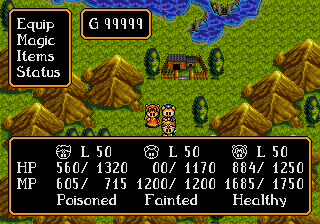 The second RPG to come out of Taiwan via Super Fighter Team, Legend of Wukong brings us three heroes on the quest to find a lost time machine after one of them accidentally used it to land in feudal China. With a humorous story and colorful visuals, it’s another sure shot for those looking for a new Genesis RPG. Newcomers be warned though: there’s a high learning curve that could cause some players to introduce their controllers to the wall, but a bit of patience (and some grinding) can easily overcome this minor hurdle. It pays off too, as Legend of Wukong is a challenging game with labyrinthine dungeons reminiscent of Phantasy Star II.
The second RPG to come out of Taiwan via Super Fighter Team, Legend of Wukong brings us three heroes on the quest to find a lost time machine after one of them accidentally used it to land in feudal China. With a humorous story and colorful visuals, it’s another sure shot for those looking for a new Genesis RPG. Newcomers be warned though: there’s a high learning curve that could cause some players to introduce their controllers to the wall, but a bit of patience (and some grinding) can easily overcome this minor hurdle. It pays off too, as Legend of Wukong is a challenging game with labyrinthine dungeons reminiscent of Phantasy Star II.
The game is available for order at its official site, so head on over and get a copy. It’ll look real nice on the shelf next to Beggar Prince!
Light Crusader
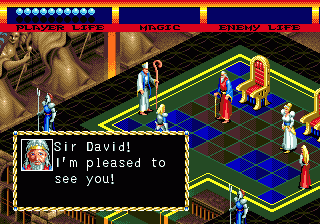 Treasure decided to make an RPG. Normally a company with the track record they had up until this point (Gunstar Heroes, Dynamite Headdy, Yu Yu Hakusho Battle) wouldn’t receive any scrutiny for testing the genre’s waters. Heck the classics I just mentioned are all totally different from each other. However, there seems to be a bit of controversy regarding Light Crusader, and some people think it’s the…least inspired of Treasure’s Genesis contributions. The Landstalker-esque isometric view can sometimes be frustrating, especially when jumping is concerned, and the storyline is a bit too run-of-the-mill for a company that made its reputation on originality and style. On the plus side, you have some excellent graphics and challenging dungeons, more than enough reason to keep playing. I like to think of Light Crusader as a game that was a victim of high expectations from a company people thought could do no wrong. Had it been published by, say, Acclaim or Sage’s Creation, it perhaps wouldn’t have come under so much fire. Taken for what it is though, Light Crusader is a fun romp that should keep you busy for a while after you’ve beaten Landstalker.
Treasure decided to make an RPG. Normally a company with the track record they had up until this point (Gunstar Heroes, Dynamite Headdy, Yu Yu Hakusho Battle) wouldn’t receive any scrutiny for testing the genre’s waters. Heck the classics I just mentioned are all totally different from each other. However, there seems to be a bit of controversy regarding Light Crusader, and some people think it’s the…least inspired of Treasure’s Genesis contributions. The Landstalker-esque isometric view can sometimes be frustrating, especially when jumping is concerned, and the storyline is a bit too run-of-the-mill for a company that made its reputation on originality and style. On the plus side, you have some excellent graphics and challenging dungeons, more than enough reason to keep playing. I like to think of Light Crusader as a game that was a victim of high expectations from a company people thought could do no wrong. Had it been published by, say, Acclaim or Sage’s Creation, it perhaps wouldn’t have come under so much fire. Taken for what it is though, Light Crusader is a fun romp that should keep you busy for a while after you’ve beaten Landstalker.
The Lunar series
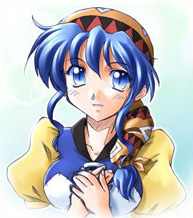 If there’s one series Genesis gamers know well, it’s Lunar. Both Silver Star and Eternal Blue are classics, and are still highly regarded and sought out, even with the more complete Playstation versions available. There’s just something about playing it on the original console that never gets old. Having different music tracks and dungeon and enemy variations doesn’t hurt either. I still believe that they’re worth having, if at least to show that spectacular story telling in an RPG did not begin with Final Fantasy VII (contrary to popular belief).
If there’s one series Genesis gamers know well, it’s Lunar. Both Silver Star and Eternal Blue are classics, and are still highly regarded and sought out, even with the more complete Playstation versions available. There’s just something about playing it on the original console that never gets old. Having different music tracks and dungeon and enemy variations doesn’t hurt either. I still believe that they’re worth having, if at least to show that spectacular story telling in an RPG did not begin with Final Fantasy VII (contrary to popular belief).
Silver Star won’t run you as much as Eternal Blue, but will still cost upwards of $25 or so (the second game can reach as high as $60). Both games feature Working Designs’ unmatched attention to quality packaging, with full-color glossy manuals and foil-stamped inserts. Silver Star even has a full compliment of seven different disc labels!
The Might & Magic series
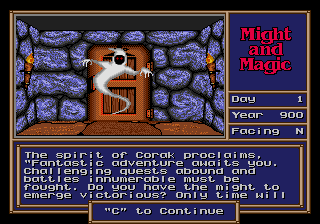 One of the very first RPGs I played after Phantasy Star II was Might & Magic: Gates to Another World. I wasn’t too knowledgeable about the PC RPG scene, and it caught my eye at the local video store. To be expected, I wasn’t too excited about it graphically, but the sheer scope and size of the game awed me. There was so much to do, so many places to explore, and it was so damn hard! Even the towns had monsters in them! I spent many hours, along with my pal Billy, hacking away at GtAW, and though we never beat it (we got stuck on the four planes), it earned a place of honor on our list of great Genesis games. The music was brilliant, the story exceptional, and the dungeons brutal. I only wish that combat had been upgraded when it was ported, since that DOS-like interface was already annoying back in 1991. If you can get past the static battle sequences and high difficulty, you’ll have yourself a game for more than a few weekends. Truly a classic.
One of the very first RPGs I played after Phantasy Star II was Might & Magic: Gates to Another World. I wasn’t too knowledgeable about the PC RPG scene, and it caught my eye at the local video store. To be expected, I wasn’t too excited about it graphically, but the sheer scope and size of the game awed me. There was so much to do, so many places to explore, and it was so damn hard! Even the towns had monsters in them! I spent many hours, along with my pal Billy, hacking away at GtAW, and though we never beat it (we got stuck on the four planes), it earned a place of honor on our list of great Genesis games. The music was brilliant, the story exceptional, and the dungeons brutal. I only wish that combat had been upgraded when it was ported, since that DOS-like interface was already annoying back in 1991. If you can get past the static battle sequences and high difficulty, you’ll have yourself a game for more than a few weekends. Truly a classic.
I’m a bit confused as to exactly how many M&M releases there were on the Genesis, as information regarding Isles of Terra is virtually nowhere to be found. It was released for the Mega CD in Japan, and certain places say that this version is identical to the 1993 Genesis release, save for the CD soundtrack, yet other indicate that only a near-complete prototype exists. I’m sure it received a domestic release on the SNES, but I’m almost positive the Genesis never got one. Perhaps a PAL or Japanese version exists?
The Phantasy Star series
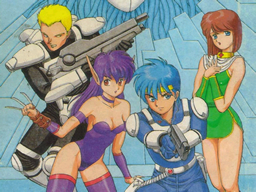 Gamers everywhere today are familiar with the online MMPORPG-lite phenomenon that is Phantasy Star Online, having played versions on just about every console out there. It’s a safe bet, however, that a good chunk of them aren’t familiar with the series’ roots, which just happens to be one of the most legendary RPG franchises in gaming history. The brainchild of legends Rieko Kodama and Yuki Naka (you know, the fellow responsible for Sonic the Hedgehog), the first sequel to the Master System monster weighed in at a hefty six megs-the largest for its time. Each successive sequel was larger, adding more dungeons, monsters, and nasty bosses to fight. Although most would argue that part four is the best, I have a soft spot in my heart for Phantasy Star II, which is still practically impossible without a guide/FAQ. Don’t believe me? Have fun doing the dams or searching for the Nei weapons on your own.
Gamers everywhere today are familiar with the online MMPORPG-lite phenomenon that is Phantasy Star Online, having played versions on just about every console out there. It’s a safe bet, however, that a good chunk of them aren’t familiar with the series’ roots, which just happens to be one of the most legendary RPG franchises in gaming history. The brainchild of legends Rieko Kodama and Yuki Naka (you know, the fellow responsible for Sonic the Hedgehog), the first sequel to the Master System monster weighed in at a hefty six megs-the largest for its time. Each successive sequel was larger, adding more dungeons, monsters, and nasty bosses to fight. Although most would argue that part four is the best, I have a soft spot in my heart for Phantasy Star II, which is still practically impossible without a guide/FAQ. Don’t believe me? Have fun doing the dams or searching for the Nei weapons on your own.
There’s too much that can be said about this awesome franchise than can fit into this tiny synopsis. The message is quite clear, though. This is the defining RPG franchise on the Genesis, and one of the top five ever made. You own a Genesis? You own these games, simple as that. Fingers are still crossed that Sega will finally decide to release the Phantasy Star Trilogy for PS2 in America, and we’ll have a full Product Review if/when it ships.
Pier Solar
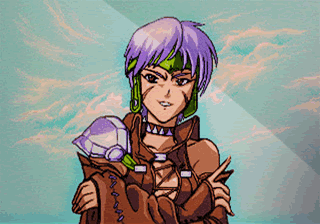 Released in 2010 by start-up developer WaterMelon Group, Pier Solar is a labor of love that was almost a decade in the making. The first game built from the ground up for the Genesis since 1998, it is perhaps one of the most spectacular adventures on the console. The quest is massive, the characters are endearing, and the game does some special effects most people thought weren’t possible on Sega’s ol’ black box. Pier Solar has seen three releases already, making it the best-selling independent game released for the Genesis since the machine was discontinued. Anyone who is a fan of RPGs needs to get a copy of this, and the plethora of goodies WaterMelon has included with each edition makes it a package too good to pass up. This is definite proof that even after all these years, Genesis still does…
Released in 2010 by start-up developer WaterMelon Group, Pier Solar is a labor of love that was almost a decade in the making. The first game built from the ground up for the Genesis since 1998, it is perhaps one of the most spectacular adventures on the console. The quest is massive, the characters are endearing, and the game does some special effects most people thought weren’t possible on Sega’s ol’ black box. Pier Solar has seen three releases already, making it the best-selling independent game released for the Genesis since the machine was discontinued. Anyone who is a fan of RPGs needs to get a copy of this, and the plethora of goodies WaterMelon has included with each edition makes it a package too good to pass up. This is definite proof that even after all these years, Genesis still does…
Pirates! Gold
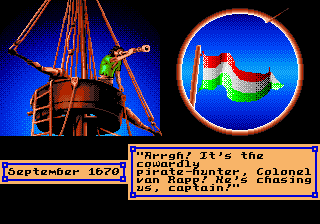 There’s a reason why the Genesis version of Sid Meier’s masterpiece fetches so much on eBay (a complete copy can go for as much as $65). One of the few RPGs that tackles an oh-so-underused part of history, it takes every boy’s childhood dream of becoming a pirate and brings it home in a way that goes beyond what you’d ever expect. Get a ship, build up a crew, and plunder the Spanish Main! Don’t like your ship? Attack and commandeer other vessels. The world map of Pirates! Gold is simply huge, and you will be hours in before you even begin to cover the map. When your not trading goods like sugar, food, or hides, you can run errands for different governors or pit the European powers against each other. It may be lacking a bit in graphics and sound, but the masterful storytelling and total interaction are why you’re playing. The one-on-one sword fights are awesome!
There’s a reason why the Genesis version of Sid Meier’s masterpiece fetches so much on eBay (a complete copy can go for as much as $65). One of the few RPGs that tackles an oh-so-underused part of history, it takes every boy’s childhood dream of becoming a pirate and brings it home in a way that goes beyond what you’d ever expect. Get a ship, build up a crew, and plunder the Spanish Main! Don’t like your ship? Attack and commandeer other vessels. The world map of Pirates! Gold is simply huge, and you will be hours in before you even begin to cover the map. When your not trading goods like sugar, food, or hides, you can run errands for different governors or pit the European powers against each other. It may be lacking a bit in graphics and sound, but the masterful storytelling and total interaction are why you’re playing. The one-on-one sword fights are awesome!
Popful Mail
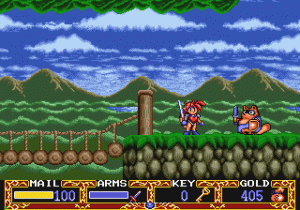 Most likely, Popful Mail is most likely my favorite of the Working Designs Sega CD releases. There’s just something about how the cast comes together, the great dialogue, and the pure 2D action/RPG bliss that was so great back in the day. Mail is a great character, and one of the best female leads I’d ever seen up until that time. She was strong and determined, yet vulnerable and greedy. All the qualities of a great bounty hunter! Her companions Tatt and Gaw don’t have the same charm she does, but being able to switch them out at any time during play was very helpful. It’s a real shame the Falcom never brought her back for another adventure. This was a game that screamed for a sequel, and it had all the right elements for kicking off a franchise. Working Designs did a great job with the translation and packaging, and gamers are finally beginning to realize just why Popful Mail deserves a permanent place in any Sega CD collection.
Most likely, Popful Mail is most likely my favorite of the Working Designs Sega CD releases. There’s just something about how the cast comes together, the great dialogue, and the pure 2D action/RPG bliss that was so great back in the day. Mail is a great character, and one of the best female leads I’d ever seen up until that time. She was strong and determined, yet vulnerable and greedy. All the qualities of a great bounty hunter! Her companions Tatt and Gaw don’t have the same charm she does, but being able to switch them out at any time during play was very helpful. It’s a real shame the Falcom never brought her back for another adventure. This was a game that screamed for a sequel, and it had all the right elements for kicking off a franchise. Working Designs did a great job with the translation and packaging, and gamers are finally beginning to realize just why Popful Mail deserves a permanent place in any Sega CD collection.
Rings of Power
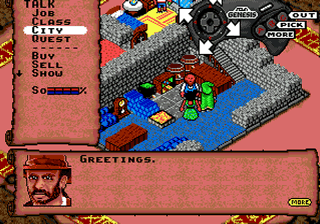 Rings of Power may not have as many rings as Tolkien’s epic trilogy, but it comes close. You play Buc, a young sorcerer who is sent by his master, the great sorcerer Thalmus, to investigate strange occurrences and rumors about the nine powerful rings appearing throughout the land. Eventually, you strive to recover the mythical artifacts. Surprisingly, Rings of Power features one of the better RPG plots for the period, and developer Naughty Dog (yep, of Crash Bandicoot & Jak & Daxter fame) created one of the largest game worlds on a 16-bit system. Huge and involving, you can practically go anywhere from the start, and you can also kill just about anything that moves, including innocent townsfolk and characters involved with the storyline (which will, of course, prevent you from completing the game). Played in an isometric view, you build up a party of six magic-wielding heroes: sorcerer (you), archer, conjurer, archer, enchanter, and necromancer. The interesting thing here is that combat does not involve armor or weapons of any kind. Magic is all that’s used.
Rings of Power may not have as many rings as Tolkien’s epic trilogy, but it comes close. You play Buc, a young sorcerer who is sent by his master, the great sorcerer Thalmus, to investigate strange occurrences and rumors about the nine powerful rings appearing throughout the land. Eventually, you strive to recover the mythical artifacts. Surprisingly, Rings of Power features one of the better RPG plots for the period, and developer Naughty Dog (yep, of Crash Bandicoot & Jak & Daxter fame) created one of the largest game worlds on a 16-bit system. Huge and involving, you can practically go anywhere from the start, and you can also kill just about anything that moves, including innocent townsfolk and characters involved with the storyline (which will, of course, prevent you from completing the game). Played in an isometric view, you build up a party of six magic-wielding heroes: sorcerer (you), archer, conjurer, archer, enchanter, and necromancer. The interesting thing here is that combat does not involve armor or weapons of any kind. Magic is all that’s used.
I really would like to see Rings of Power remade for modern consoles. The cool trading feature- bringing area-exclusive goods to other towns to sell- and the unique combat system are still pretty underused today. Combined with the huge quest and interesting plot, this game would be very welcome in today’s open-minded RPG market, with only the presentation really needing to be upgraded. Hopefully Naughty Dog and/or EA will realize this and make it happen.
Shadowrun
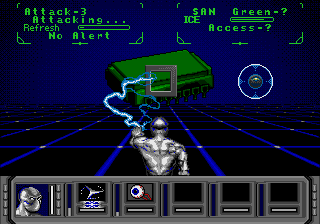 There seems to be a lot of confusion about Shadowrun in regards to the different versions that have been released. Both the Genesis and SNES got domestic releases, and the Mega CD got one that was unfortunately left in Japan. Ironically, Japan never got the cartridge edition. As to which of the console renditions is superior, I prefer to let each player decide for themselves. Personally, I prefer the Genesis Shadowrun because the story just flows better and seems more gritty. The smaller color palate also lent itself to better illustrate the gritty, futuristic world the game was trying to convey (who would have thought that it’d ever be an asset?). All this was complimented by some great gameplay, that was fun enough to warrant successive playthroughs- something RPGs are notorious for lacking. I really enjoyed the cybercombat and thought the change in perspective was very refreshing and well done. Fans of the FASA pen & paper RPG will really want to try out this gem.
There seems to be a lot of confusion about Shadowrun in regards to the different versions that have been released. Both the Genesis and SNES got domestic releases, and the Mega CD got one that was unfortunately left in Japan. Ironically, Japan never got the cartridge edition. As to which of the console renditions is superior, I prefer to let each player decide for themselves. Personally, I prefer the Genesis Shadowrun because the story just flows better and seems more gritty. The smaller color palate also lent itself to better illustrate the gritty, futuristic world the game was trying to convey (who would have thought that it’d ever be an asset?). All this was complimented by some great gameplay, that was fun enough to warrant successive playthroughs- something RPGs are notorious for lacking. I really enjoyed the cybercombat and thought the change in perspective was very refreshing and well done. Fans of the FASA pen & paper RPG will really want to try out this gem.
Shadowrun can be hard in the early going, but if you stick with it, like most great games, the sense of reward and accomplishment you’ll get from finishing it will make you want to tackle it again. That is the definition of a true classic.
The Shining Force series
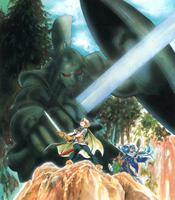 A series which needs no introduction, the Shining Force series had one heck of a run on the Genesis. The original and its sequel were just what the console needed, giving RPGs a shot in the arm by adding some wicked strategy battles that wowed gamers with impressive spell and fighting animations. Shining in the Darkness veterans were instantly at home with the menu system, and were pleasantly surprised to see that the Force games were part of the same universe. That’s what makes this franchise so special; plot elements and characters can turn up anywhere, like the Vandals of Shining the Holy Ark appearing in Shining Force III on Saturn, or the original Shining Force‘s ninja Hanzou being a resident of StHA‘s Far East Village. That kind of cohesion really brings out the charm inherent in the franchise, and makes you want to go out and play all the games, a daunting task considering that they are found on a grand total of five systems (damn you Sega!).
A series which needs no introduction, the Shining Force series had one heck of a run on the Genesis. The original and its sequel were just what the console needed, giving RPGs a shot in the arm by adding some wicked strategy battles that wowed gamers with impressive spell and fighting animations. Shining in the Darkness veterans were instantly at home with the menu system, and were pleasantly surprised to see that the Force games were part of the same universe. That’s what makes this franchise so special; plot elements and characters can turn up anywhere, like the Vandals of Shining the Holy Ark appearing in Shining Force III on Saturn, or the original Shining Force‘s ninja Hanzou being a resident of StHA‘s Far East Village. That kind of cohesion really brings out the charm inherent in the franchise, and makes you want to go out and play all the games, a daunting task considering that they are found on a grand total of five systems (damn you Sega!).
In addition to the awesome original and its sequel, the Sega CD boasts one awesome-but-overlooked gem in Shining Force CD. A combination of both Game Gear titles, it also adds an extra battle that requires the backup RAM cart to access. This neat extra features all twenty-four heroes from both games, allowing you to choose your twelve from the expanded cast.
RPG fans looking for a simple yet engaging way to spend some time need to have the Shining Force games in their library. This is a great series and a must for Genny owners.
Shining in the Darkness
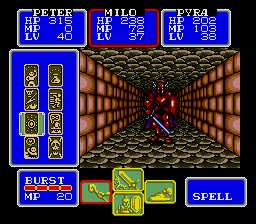 The one that started it all, Shining in the Darkness is the granddaddy of a series that has spanned more titles in more genres than any other console RPG. Back when it was released, gamers were awed by the colorful, cartoony graphics, and humbled by the relentless, claustrophobic dungeons that seemingly went on forever (the trials! I still weep when I think about them!). You only had three characters and there was but a single town to explore, but what an adventure this was. Who could forget the incredible magic effects, or those bastard monsters that would howl for help when you killed their comrades? This was also the first game to include Climax’s universal menu system (still seen today in games like Golden Sun for the GBA), which had tiny icons to accompany the text, making the game very import-friendly for an RPG. I’ve played through my copy a few times and it never gets old. The beautiful graphics, wonderful soundtrack, and one of the best endings for a cartridge RPG of the time, all are part and parcel of this RPG classic.
The one that started it all, Shining in the Darkness is the granddaddy of a series that has spanned more titles in more genres than any other console RPG. Back when it was released, gamers were awed by the colorful, cartoony graphics, and humbled by the relentless, claustrophobic dungeons that seemingly went on forever (the trials! I still weep when I think about them!). You only had three characters and there was but a single town to explore, but what an adventure this was. Who could forget the incredible magic effects, or those bastard monsters that would howl for help when you killed their comrades? This was also the first game to include Climax’s universal menu system (still seen today in games like Golden Sun for the GBA), which had tiny icons to accompany the text, making the game very import-friendly for an RPG. I’ve played through my copy a few times and it never gets old. The beautiful graphics, wonderful soundtrack, and one of the best endings for a cartridge RPG of the time, all are part and parcel of this RPG classic.
Sorcerer’s Kingdom
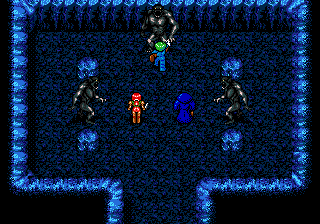 Cut from the same mold as other mediocre RPGs on this list (I glare ominously at Sword of Vermilion) Treco’s Sorcerer’s Kingdom is a bland attempt at the genre that never really gets going. The plot is very generic (young lad out for adventure!), and the graphics, while decent, do nothing to make the story even the slightest bit believable. Combat moves so fast that you won’t even realize it’s ended for the first couple of battles, adding in some unnecessary frustration to an already tedious affair. It’s funny how many RPGs of the era fall into this trap, and how totally oblivious I was to it back then. This is one of those times when I wish nostalgia wasn’t a factor. Friends, you’ve been here too many times before, and under better circumstances. I won’t go so far as to tell you to avoid Sorcerer’s Kingdom, but I will leave you with a simple warning: don’t go in with high expectations.
Cut from the same mold as other mediocre RPGs on this list (I glare ominously at Sword of Vermilion) Treco’s Sorcerer’s Kingdom is a bland attempt at the genre that never really gets going. The plot is very generic (young lad out for adventure!), and the graphics, while decent, do nothing to make the story even the slightest bit believable. Combat moves so fast that you won’t even realize it’s ended for the first couple of battles, adding in some unnecessary frustration to an already tedious affair. It’s funny how many RPGs of the era fall into this trap, and how totally oblivious I was to it back then. This is one of those times when I wish nostalgia wasn’t a factor. Friends, you’ve been here too many times before, and under better circumstances. I won’t go so far as to tell you to avoid Sorcerer’s Kingdom, but I will leave you with a simple warning: don’t go in with high expectations.
Star Odyssey
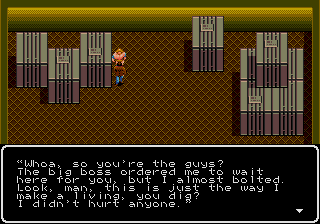 The third RPG release from Super Fighter Team, Star Odyssey originally began as a Japanese game called Blue Almanac. It was scheduled to be localized by Sage’s Creation (Shadow Blasters, Insector X), but the company went under before the game could be brought to the west. Left to languish unfinished for two decades, it was rescued by SFT and received a major overhaul. Everything from its script to even the title screen was cleaned up. It might not seem as revolutionary now, but even after 20+ years, Star Odyssey is making history. It marks the first officially licensed Japanese title for a discontinued console, and its successful release is already bearing fruit. Super Fighter Team has since secured licenses for other Japanese games, which means that we’ll be seeing more sanctioned titles make their way out of the Land of the Rising Sun.
The third RPG release from Super Fighter Team, Star Odyssey originally began as a Japanese game called Blue Almanac. It was scheduled to be localized by Sage’s Creation (Shadow Blasters, Insector X), but the company went under before the game could be brought to the west. Left to languish unfinished for two decades, it was rescued by SFT and received a major overhaul. Everything from its script to even the title screen was cleaned up. It might not seem as revolutionary now, but even after 20+ years, Star Odyssey is making history. It marks the first officially licensed Japanese title for a discontinued console, and its successful release is already bearing fruit. Super Fighter Team has since secured licenses for other Japanese games, which means that we’ll be seeing more sanctioned titles make their way out of the Land of the Rising Sun.
STNG: Echoes from the Past
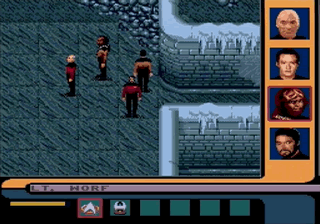 There have been a lot of attempts at bringing the Next Generation series to consoles, and of the bunch, I feel that Echoes from the Past is one of the best. It was pretty ambitious, given the hardware limitations of the time (this would have been wonderful on the Sega CD!), and there’s a steep learning curve that tends to throw off some gamers. Once you give it a chance, however, you’ll soon find yourself choosing your away teams to go repair damaged alien ships or explore strange new worlds. If there’s a problem with SNG, it’s that the game follows the series’ formula a bit too much. Many times, your away team will get wiped out, usually starting with that nameless security extra you decided to fill the last slot with. Most missions result in Data being a one-man gang, given his imperviousness to poison gas, heavy gravity, as well as his high stamina. Space combat can be a bit confusing too, and you’ll initially find yourself wandering around trying to find your opponent, who just seems to always know exactly where you are. Notwithstanding, Echoes is highly enjoyable, especially for Trekkies. There’s not much else out there on the system, aside from Starship Bridge Simulator, but this does quite nicely.
There have been a lot of attempts at bringing the Next Generation series to consoles, and of the bunch, I feel that Echoes from the Past is one of the best. It was pretty ambitious, given the hardware limitations of the time (this would have been wonderful on the Sega CD!), and there’s a steep learning curve that tends to throw off some gamers. Once you give it a chance, however, you’ll soon find yourself choosing your away teams to go repair damaged alien ships or explore strange new worlds. If there’s a problem with SNG, it’s that the game follows the series’ formula a bit too much. Many times, your away team will get wiped out, usually starting with that nameless security extra you decided to fill the last slot with. Most missions result in Data being a one-man gang, given his imperviousness to poison gas, heavy gravity, as well as his high stamina. Space combat can be a bit confusing too, and you’ll initially find yourself wandering around trying to find your opponent, who just seems to always know exactly where you are. Notwithstanding, Echoes is highly enjoyable, especially for Trekkies. There’s not much else out there on the system, aside from Starship Bridge Simulator, but this does quite nicely.
Super Hydlide
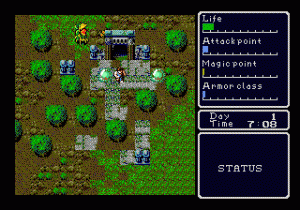 In the grand scheme of things, Super Hydlide goes unnoticed. It’s almost never mentioned in the same breath as any of the more popular RPGs listed here, and those who do know about it usually have something negative to say. That’s unfortunate, as Super Hydlide really is an enjoyable game. The graphics are indeed tiny (sometimes too tiny), but that is really its only fault. This was one of the first console RPGs that I can remember where your character’s sprite changed depending on what armor he had equipped. Having too much equipment would also slow him down, and you even had a money changer to convert coins to lighter currency! You had to sleep and eat, and actually had to go to a mage’s guild to learn spells (none of this *poof* I learned a spell stuff). The soundtrack was absolutely incredible, and the variety of enemies and dungeons made for a great quest. Super Hydlide also distinguishes itself for having one of the most offbeat final boss battles in the genre. I won’t spoil it, but let’s just say it involves something you’d never consider doing.
In the grand scheme of things, Super Hydlide goes unnoticed. It’s almost never mentioned in the same breath as any of the more popular RPGs listed here, and those who do know about it usually have something negative to say. That’s unfortunate, as Super Hydlide really is an enjoyable game. The graphics are indeed tiny (sometimes too tiny), but that is really its only fault. This was one of the first console RPGs that I can remember where your character’s sprite changed depending on what armor he had equipped. Having too much equipment would also slow him down, and you even had a money changer to convert coins to lighter currency! You had to sleep and eat, and actually had to go to a mage’s guild to learn spells (none of this *poof* I learned a spell stuff). The soundtrack was absolutely incredible, and the variety of enemies and dungeons made for a great quest. Super Hydlide also distinguishes itself for having one of the most offbeat final boss battles in the genre. I won’t spoil it, but let’s just say it involves something you’d never consider doing.
I was sad to see Seismic fold its tent and leave the industry. With quality titles like Super Hydlide and M.U.S.H.A., they were one of the best early third part companies the Genesis had.
Sword of Vermilion
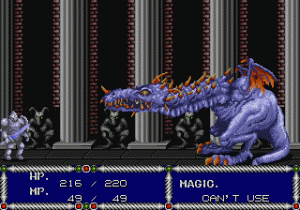 When you actually play Sword of Vermilion, it’s hard to believe that it’s the product of Sega’s game guru Yu Suzuki and his AM2 group. It lacks all the polish and perfection their titles are known for, and falls short of the mark in most places an RPG should excel. Granted, Suzuki & friends had never attempted a full-blown RPG before, but I fail to see how this genre would be any different from any of the others they pioneered. The music is godly, and the graphics are excellent, but the plot is as cookie cutter as they come, and the boss battles are depressing. I liked the idea of exploring in a first-person perspective and then switching to a real time 3rd person view for combat, but with AI as dumb as this, the fun is sapped out completely. Even worse, the über linear gameplay turned Vermilion into a connect-the-dots exercise in boredom. Go to a town, find out what precious item has been stolen, get the map to the cave and retrieve said item, return said item to king and get a map to the next area. Wash, rinse, repeat. Even so, Sword of Vermilion is a decent way to spend an afternoon (it’s only about twelve hours long), and it’s worth tracking down a copy for the sound test alone. Just don’t expect a religious experience.
When you actually play Sword of Vermilion, it’s hard to believe that it’s the product of Sega’s game guru Yu Suzuki and his AM2 group. It lacks all the polish and perfection their titles are known for, and falls short of the mark in most places an RPG should excel. Granted, Suzuki & friends had never attempted a full-blown RPG before, but I fail to see how this genre would be any different from any of the others they pioneered. The music is godly, and the graphics are excellent, but the plot is as cookie cutter as they come, and the boss battles are depressing. I liked the idea of exploring in a first-person perspective and then switching to a real time 3rd person view for combat, but with AI as dumb as this, the fun is sapped out completely. Even worse, the über linear gameplay turned Vermilion into a connect-the-dots exercise in boredom. Go to a town, find out what precious item has been stolen, get the map to the cave and retrieve said item, return said item to king and get a map to the next area. Wash, rinse, repeat. Even so, Sword of Vermilion is a decent way to spend an afternoon (it’s only about twelve hours long), and it’s worth tracking down a copy for the sound test alone. Just don’t expect a religious experience.
TechnoClash
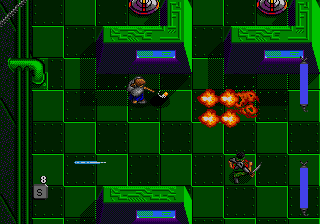 Slipping through the cracks into relative obscurity, Electronic Arts’ TechnoClash is a title that really should be given a chance. The whole “technology vs. magic” motif is very well done, giving the game a dank and dreary futuristic vibe that harks to such iconic titles as Shadowrun and Snatcher. Ronaan, prince of the Inner World which has shunned technology, has been brought here against his will. His only hope of ever returning home lies with the mysterious “Machine Man,” who holds the key to freeing the Inner World from the evil Robot Lord. There’s a bunch of different areas to explore -seven in all, each with up to nine levels- and you’re accompanied by one of two different bodyguards. The game is very well done, both graphically and gameplay-wise, and is quite a departure from the standard “young boy who must save the kingdom” plots sported by most RPGs of the day.
Slipping through the cracks into relative obscurity, Electronic Arts’ TechnoClash is a title that really should be given a chance. The whole “technology vs. magic” motif is very well done, giving the game a dank and dreary futuristic vibe that harks to such iconic titles as Shadowrun and Snatcher. Ronaan, prince of the Inner World which has shunned technology, has been brought here against his will. His only hope of ever returning home lies with the mysterious “Machine Man,” who holds the key to freeing the Inner World from the evil Robot Lord. There’s a bunch of different areas to explore -seven in all, each with up to nine levels- and you’re accompanied by one of two different bodyguards. The game is very well done, both graphically and gameplay-wise, and is quite a departure from the standard “young boy who must save the kingdom” plots sported by most RPGs of the day.
Traysia
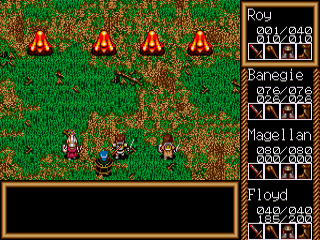 Looking for a good, simple RPG to get started with? Here you go. Traysia is to the Genesis what Final Fantasy Mystic Quest is to the SNES. Inexpensive and easy to find, it’s great for those just getting their feet wet in the genre. How relevant that is today, with the huge, CD-filled, 100+ million side quest epics released on the modern systems, I’m not sure, but that doesn’t mean the game isn’t worth giving a try. The story tells of yet another young boy out to save the world and after you say goodbye to your lady love Traysia, you’re off to make your way in life as a bad ass monster killer. I love these “here’s a stick and a nickel, go conquer the world kid” RPGs, and Traysia is a textbook example of this. Combat is a little hokey, and I don’t like the “main character dies and it’s all over” shtick, but everything else makes for a decent play. Go into town,s upgrade equipment, and do all the other stuff that we’ve come to know and love from RPGs. Being an early release from Renovation, the graphics and sound might woo you towards the power button, but as with most games on this list, give it a chance!
Looking for a good, simple RPG to get started with? Here you go. Traysia is to the Genesis what Final Fantasy Mystic Quest is to the SNES. Inexpensive and easy to find, it’s great for those just getting their feet wet in the genre. How relevant that is today, with the huge, CD-filled, 100+ million side quest epics released on the modern systems, I’m not sure, but that doesn’t mean the game isn’t worth giving a try. The story tells of yet another young boy out to save the world and after you say goodbye to your lady love Traysia, you’re off to make your way in life as a bad ass monster killer. I love these “here’s a stick and a nickel, go conquer the world kid” RPGs, and Traysia is a textbook example of this. Combat is a little hokey, and I don’t like the “main character dies and it’s all over” shtick, but everything else makes for a decent play. Go into town,s upgrade equipment, and do all the other stuff that we’ve come to know and love from RPGs. Being an early release from Renovation, the graphics and sound might woo you towards the power button, but as with most games on this list, give it a chance!
The Uncharted Waters series
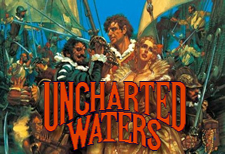 Ok, you’ve played through Pirates! Gold (or perhaps can’t afford a copy), and are still aching for some corsair action. What to do? Easy, get yourself a copy of either of the Uncharted Waters games and have a blast! The first one, The Sea Prince, can be a bit dull in places, but it’s still a fun title. I prefer the second game, New Horizons, which takes the concept to great new heights. Choosing from several captains, including woman (try not to think of Geena Davis), makes for some great replay value, and though the super-deformed graphics may prompt you to snicker, the wonderful plot and solid gameplay will shut you up right quick. A typical RPG of the era, you’ll explore towns and search for treasure as you live the life of an adventurer. The first game has you setting out to restore honor to your family name, but the sequel is less linear. Each of the six characters has his/her own storyline, which was a really novel idea at the time.
Ok, you’ve played through Pirates! Gold (or perhaps can’t afford a copy), and are still aching for some corsair action. What to do? Easy, get yourself a copy of either of the Uncharted Waters games and have a blast! The first one, The Sea Prince, can be a bit dull in places, but it’s still a fun title. I prefer the second game, New Horizons, which takes the concept to great new heights. Choosing from several captains, including woman (try not to think of Geena Davis), makes for some great replay value, and though the super-deformed graphics may prompt you to snicker, the wonderful plot and solid gameplay will shut you up right quick. A typical RPG of the era, you’ll explore towns and search for treasure as you live the life of an adventurer. The first game has you setting out to restore honor to your family name, but the sequel is less linear. Each of the six characters has his/her own storyline, which was a really novel idea at the time.
This series was overlooked when released, perhaps due to other high profile games like Shining Force or Phantasy Star III which came out the same year. Maybe it was the average gamer’s automatic association of the KOEI brand with complicated historical strategy games that drove people away. Whatever the reason was, it kept a lot of people from enjoying this awesome series. Find them and see what you were missing.
Vay
 Many gamers rank Vay as one of the best RPGs on the Sega CD. While I can appreciate the sentiment, there are a few glaring issues that keep it from glory in my book. The random battles are mind-numbing, essentially reducing the game to a frustrating exercise of “step and fight, step and fight” that can make the long treks through dungeons almost torture. Add the fact that healing items are almost useless, and the difficulty level becomes needlessly overbearing. There is a decent game here, though, and the story, though somewhat generic, is cool enough to follow. Vay also boasts one of the bigger twists in RPGs of the day, killing off a main character long before anyone knew who the hell Aeris was. Working Designs always released quality games for the Sega CD, and if you can wade through the difficulty and so-so plot, this is a good addition to your library.
Many gamers rank Vay as one of the best RPGs on the Sega CD. While I can appreciate the sentiment, there are a few glaring issues that keep it from glory in my book. The random battles are mind-numbing, essentially reducing the game to a frustrating exercise of “step and fight, step and fight” that can make the long treks through dungeons almost torture. Add the fact that healing items are almost useless, and the difficulty level becomes needlessly overbearing. There is a decent game here, though, and the story, though somewhat generic, is cool enough to follow. Vay also boasts one of the bigger twists in RPGs of the day, killing off a main character long before anyone knew who the hell Aeris was. Working Designs always released quality games for the Sega CD, and if you can wade through the difficulty and so-so plot, this is a good addition to your library.
Warsong
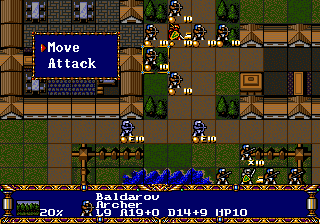 Strategy/RPG hybrids are quite popular, and one of the better series out there was Masaya’s Langrisser. In the infinite wisdom of the localization process, only the first game made it stateside. Renamed Warsong, it gave Genesis owners a small glimpse of the genre outside of Shining Force. The game centers around Prince Garrett’s quest to recover the ancient sword Warsong before the evil empire that invaded his kingdom can recover it first. More original than the plot is the gameplay: the thing that really counts. You command a force of up to eight generals per scenario (or chapter), and they in turn have their own troops. As you progress, each general gains experience and can eventually be promoted to a different class. If one should die in battle, you lost him for the rest of the game. Fortunately, Warsong is easy enough for this to not be a regular occurrence, and it will be mostly your poor troops getting slaughtered, in cool little battle scenes. Quite pricey but more than worth the price, Warsong is a great way to kill a few days, and an excellent choice for those eager for another quality action/RPG after Shining Force.
Strategy/RPG hybrids are quite popular, and one of the better series out there was Masaya’s Langrisser. In the infinite wisdom of the localization process, only the first game made it stateside. Renamed Warsong, it gave Genesis owners a small glimpse of the genre outside of Shining Force. The game centers around Prince Garrett’s quest to recover the ancient sword Warsong before the evil empire that invaded his kingdom can recover it first. More original than the plot is the gameplay: the thing that really counts. You command a force of up to eight generals per scenario (or chapter), and they in turn have their own troops. As you progress, each general gains experience and can eventually be promoted to a different class. If one should die in battle, you lost him for the rest of the game. Fortunately, Warsong is easy enough for this to not be a regular occurrence, and it will be mostly your poor troops getting slaughtered, in cool little battle scenes. Quite pricey but more than worth the price, Warsong is a great way to kill a few days, and an excellent choice for those eager for another quality action/RPG after Shining Force.
The Monster World series
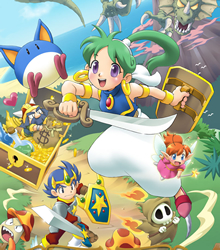 Where have you gone Wonder Boy? Ever since the incredible Monster World IV, you’ve simply vanished. I know there are legions of fans out there just waiting for this series to make a comeback, and I was sure that at least one game would make an appearance on the GBA. Sadly, another hardware generation has come and gone, and still the franchise remains dormant. Were Sega even slightly intelligent, they would package these games into a compilation and make a few bucks. Although only two of the action/RPG-style games made appearances on the Genesis, we did get the hybrid shmup/run-‘n-gun Monster Lair, which was available in Europe and Japan only. For those reluctant to play the final installment in Japanese, there is an English version floating around on the web (you’ll have to look for it yourself), and regardless of which version you choose, you simply need to play this game. While you’re looking, go and get a copy of Wonder Boy in Monster World and see just why we need more from this great property.
Where have you gone Wonder Boy? Ever since the incredible Monster World IV, you’ve simply vanished. I know there are legions of fans out there just waiting for this series to make a comeback, and I was sure that at least one game would make an appearance on the GBA. Sadly, another hardware generation has come and gone, and still the franchise remains dormant. Were Sega even slightly intelligent, they would package these games into a compilation and make a few bucks. Although only two of the action/RPG-style games made appearances on the Genesis, we did get the hybrid shmup/run-‘n-gun Monster Lair, which was available in Europe and Japan only. For those reluctant to play the final installment in Japanese, there is an English version floating around on the web (you’ll have to look for it yourself), and regardless of which version you choose, you simply need to play this game. While you’re looking, go and get a copy of Wonder Boy in Monster World and see just why we need more from this great property.
Ys III: Wanderers from Ys
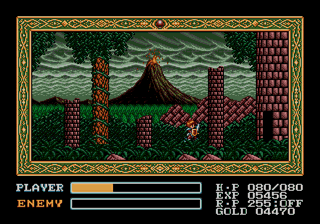 Turbo Grafx-16 fans were truly blessed in that they received a grand total of four adventures featuring the red headed hero, Ado Christian. Genesis owners only got one, Wanderers from Ys, which has been wrongly categorized by many as the worst of the bunch, due to its departure from the classic formula (sort of like the Adventures of Link of the series). The Genesis port lost the awesome cinematics of the CD original, and the godly soundtrack has taken a big hit, but the gameplay is intact, and the graphics are actually better. I prefer this version over the SNES port, whose only claim to fame is a whopping fifteen save slots! They kind of went overboard with the soundtrack too, and the Genesis version sounds closer to the original. Though different in style from the other Ys games, Wanderers is an excellent title that never lets up. There are a ton of areas to explore, and the boss battles rock. If you can’t get a Duo and the CD version, this is definitely the way to go.
Turbo Grafx-16 fans were truly blessed in that they received a grand total of four adventures featuring the red headed hero, Ado Christian. Genesis owners only got one, Wanderers from Ys, which has been wrongly categorized by many as the worst of the bunch, due to its departure from the classic formula (sort of like the Adventures of Link of the series). The Genesis port lost the awesome cinematics of the CD original, and the godly soundtrack has taken a big hit, but the gameplay is intact, and the graphics are actually better. I prefer this version over the SNES port, whose only claim to fame is a whopping fifteen save slots! They kind of went overboard with the soundtrack too, and the Genesis version sounds closer to the original. Though different in style from the other Ys games, Wanderers is an excellent title that never lets up. There are a ton of areas to explore, and the boss battles rock. If you can’t get a Duo and the CD version, this is definitely the way to go.
There you have it, folks, every RPG the Genesis has to offer. Funny isn’t it? Many people deride the system for not having enough RPGs, and say that it has a glut of shmups. Purely an ignorant argument, as the Genesis overall has a grand total of over seventy RPGs, almost as many as it has shmups. So either there aren’t enough shmups, or there are plenty of games in both genres.
I’m sure there’s something on this list, or in our Left in Japan: RPGs feature that you’ll enjoy. Some of the greatest RPGs ever made are on both lists, and you’d be doing yourself a disservice by passing them up.

Recent Comments